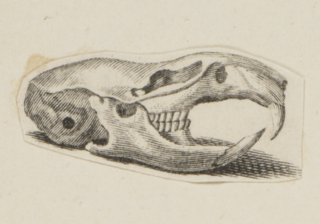Related Research Articles

Nankeen is a kind of pale yellowish cloth originally made in Nanjing, China from a yellow variety of cotton, but subsequently manufactured from ordinary cotton that is then dyed.

The chestnut-bellied sandgrouse or common sandgrouse is a species of sandgrouse. It is a sedentary and nomadic species that ranges from northern and central Africa and further east towards western and southern Asia. There are six recognised subspecies.

The rusty pitohui is a species of bird in the family Pachycephalidae. It is found throughout the lowlands of the Aru Islands and New Guinea.

Theretra nessus, the yam hawk moth, is a moth of the family Sphingidae. It was described by Dru Drury in 1773.
Lemniscomys linulus, commonly known as the Senegal grass mouse or Senegal one-striped grass mouse, is a species of rodent in the family Muridae. It is found in Ivory Coast, Guinea, Mali, and Senegal and its natural habitat is dry savanna. At one time considered to be a subspecies of Lemniscomys griselda, it is now accepted as a species in its own right.

The narrow-headed vole is a species of rodent in the family Cricetidae. Ranging over northern and central Asia and also into Alaska, it is the only species in the subgenus Stenocranius.

The Andean flicker is a South American species of woodpecker. It is found in grassland, shrubland and Polylepis woodland at altitudes of 2,000–5,000 metres (6,600–16,400 ft) in the Puna ecoregion. Together with the campo flicker and ground woodpecker, it is one of the few largely terrestrial woodpeckers.

The southern pocket gopher is a species of rodent in the family Geomyidae. It is found in Mexico and the United States, usually in high altitude grassland and shrubland. It feeds on plant material and has an extensive burrow above which is a large heap of earth on the surface of the ground.

Gymnopilus aeruginosus, also known as the Magic Blue Gym, is a mushroom which grows in clusters on dead wood and wood chip mulch. It is widely distributed and common in the Pacific Northwest. It has a rusty orange spore print and a bitter taste and contains the hallucinogen psilocybin. It was given its current name by mycologist Rolf Singer in 1951.

Gymnopilus validipes is a widely distributed mushroom of North America and Europe. Gymnopilus validipes contains the hallucinogens psilocybin and psilocin. The mild taste of this mushroom stands in contrast to closely related bitter species. Validipes means "having a robust stalk." Gymnopilus validipes contains about 0.12% psilocybin.
Sabatinca calliarcha is a species of moth belonging to the family Micropterigidae. It was described by Edward Meyrick in 1912. It is known from New Zealand.
Endotricha medogana is a species of snout moth in the genus Endotricha. It was described by Wang and Li, in 2005, and is known from China (Tibet).
Oxybia is a monotypic snout moth genus described by Hans Rebel in 1901. Its only species, Oxybia transversella, was described by Philogène Auguste Joseph Duponchel in 1836. It is found in southern Europe and on the Canary Islands.
Neptosternus arnecornelii is a species of beetle, named after Arne Cornelius. Its holotype was found in West Kalimantan, Indonesia. The specimens were captured floating on tree roots in a rocky mountain stream near a forest. Neptosternus arnecornelii superficially resembles N. biltoni from the Togian Islands northeast of Sulawesi. It is a small, broadly ovate species; with its body strongly flattened laterally.

Loxostege lepidalis is a moth in the family Crambidae. It was described by George Duryea Hulst in 1886. It is found in North America, where it has been recorded from Alberta and eastern Washington to California and New Mexico. The habitat consists of prairies and badlands.
Pyrausta subsequalis is a moth in the family Crambidae. It was described by Achille Guenée in 1854. It is found in North America, where it has been recorded from southern Alberta and southern British Columbia south to Arizona and New Mexico. The habitat consists of dry prairie areas.
Pyrausta borealis, the northern pyrausta moth, is a moth in the family Crambidae. It was described by Alpheus Spring Packard in 1867. It is found in North America, where it has been recorded from Newfoundland and Labrador west to British Columbia, north to Alaska and the Yukon. The habitat consists of boreal forests.
Trigonoorda triangularis is a moth in the family Crambidae. It was described by Munroe in 1974. It is found in New Guinea.
Stenorista fortunata is a moth in the family Crambidae. It was described by Schaus in 1912. It is found in Costa Rica.
Negera confusa is a moth in the family Drepanidae. It was described by Francis Walker in 1855. It is found in Cameroon, Ghana, Ivory Coast, Nigeria, Sierra Leone and the Gambia.
References
- ↑ "global Pyraloidea database". Globiz.pyraloidea.org. Retrieved 2014-07-15.
- ↑ Pyralidae of the Third Archbold Expedition. 1. Subfamily Odontiinae (Lepidoptera)
| This Odontiinae-related article is a stub. You can help Wikipedia by expanding it. |